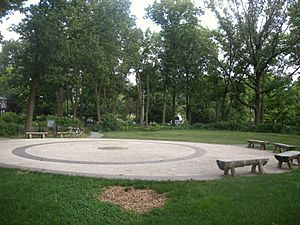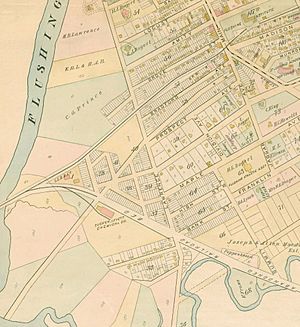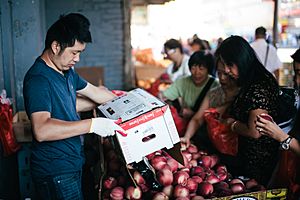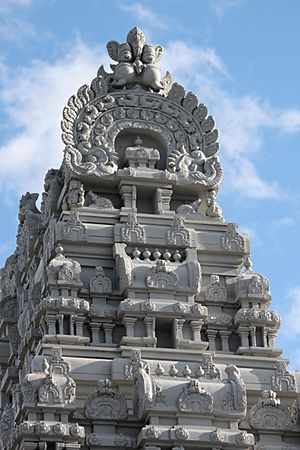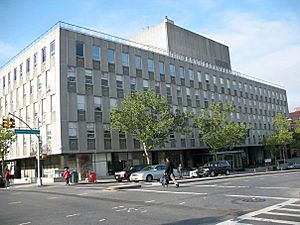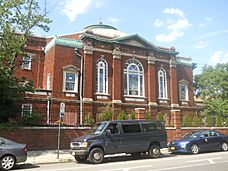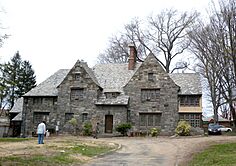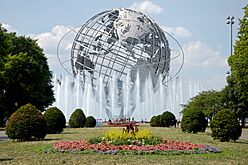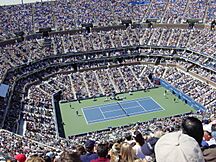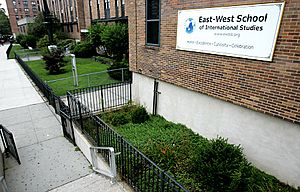Flushing, Queens facts for kids
Quick facts for kids
Flushing
|
|
|---|---|
|
Neighborhood in Queens
|
|

Aerial view of the neighborhood
|
|
| Country | |
| State | |
| City | New York City |
| County/Borough | Queens |
| Community District | Queens 7 |
| Founded | 1645 |
| Town | 1683–1898 |
| Named for | Vlissingen, Netherlands |
| Population
(2010)
|
|
| • Total | 72,008 (176,000 with the subsections) |
| Race/Ethnicity | |
| • White | 9.5% |
| • Black | 4.2% |
| • Hispanic | 14.9% |
| • Asian | 69.2% |
| • Other/Multiracial | 2.2% |
| Economics | |
| • Median income | ,804 |
| Time zone | UTC– 05:00 (EST) |
| • Summer (DST) | UTC– 04:00 (EDT) |
| ZIP Codes |
11354, 11355, 11358
|
| Area codes | 718, 347, 929, and 917 |
Flushing is a lively neighborhood in the northern part of Queens, one of New York City's five boroughs. It's a major center for business and shopping, ranking as the fourth largest in New York City. The intersection of Main Street and Roosevelt Avenue is super busy, only behind Times Square and Herald Square in activity.
Flushing was founded on October 10, 1645, by the Dutch. They named it Vlissingen, after a city in the Netherlands. When the English took over in 1664, they started calling it Flushing. In 1898, Flushing became part of the larger New York City. In the 20th century, new bridges and public transportation helped the area grow. Many immigrants, especially from China, India, and Korea, moved to Flushing in the late 1900s.
Today, Flushing is known for its many different neighborhoods and cultures. You can travel around Flushing using the Long Island Rail Road or the New York City Subway's 7 <7> trains train, which ends at Main Street. Flushing is part of Queens Community District 7. Its main ZIP Codes are 11354, 11355, and 11358. The New York City Police Department's 109th Precinct keeps the area safe.
Contents
Discover Flushing's Rich History
Early Days as a Dutch Colony
Flushing was started by the Dutch on October 10, 1645. It was part of the New Netherland colony. The settlement was named after Vlissingen, a city in the southwestern Netherlands. This city was a main port for the Dutch West India Company. Over time, the name changed from "Vlissing" to "Flushing," which was the British name for Vlissingen. Even though it was a Dutch colony, many early settlers were British.
Flushing's original charter was special. It allowed people to practice their religion freely, unlike other towns. However, Peter Stuyvesant, the leader of New Amsterdam, tried to stop people from helping Quakers. On December 27, 1657, the people of Flushing wrote a protest called The Flushing Remonstrance. This document argued for religious freedom for everyone. It even mentioned "Jews, Turks, and Egyptians." It strongly stated that the town's charter should be respected.
Later, a farmer named John Bowne held Quaker meetings in his home. He was arrested and sent to Holland. But he convinced the Dutch West India Company to allow Quakers and others to worship freely. Because of this, Flushing is seen as a birthplace of religious freedom in the New World. You can still see landmarks from the Dutch period today. These include the John Bowne House and the Old Quaker Meeting House.
Flushing Under English Rule
In 1664, the English took control of New Amsterdam. They renamed it the Province of New York. In 1683, Queens County was created. The "Town of Flushing" was one of its first five towns. Many old stories about Flushing refer to this larger town. It was bordered by Flushing Creek to the west.
The first commercial tree nurseries in North America were in Flushing. The Prince, Bloodgood, and Parsons nurseries were very famous. Even today, parts of Kissena Park have many different kinds of exotic trees. Streets near Kissena Boulevard are named after trees. Flushing also provided trees for Central Park in Manhattan.
During the American Revolution, Flushing supported the British. British troops stayed there. Nathan Hale, an American officer, was caught near Flushing Bay. He was on a spy mission and later hanged. The 1785 Kingsland Homestead was once a wealthy Quaker merchant's home. Now, it is home to the Queens Historical Society.
Growing in the 19th Century
Flushing grew as New York City became bigger. Being close to Manhattan helped it become a popular place to live. On April 15, 1837, the Village of Flushing was officially formed. By the mid-1860s, Queens County had over 30,000 residents. Flushing continued to grow, and two new villages, College Point and Whitestone, were created.
In 1898, the Town of Flushing became part of New York City. It joined to form the new Borough of Queens. All the smaller towns and villages within Queens were dissolved. Farmland in Flushing was divided and built upon. This turned Flushing into a busy neighborhood of New York City.
Development in the 20th Century
New bridges over the Flushing River helped more cars come into Flushing. In 1909, the Queensboro Bridge opened. This bridge connected Queens to midtown Manhattan.
Train service to Manhattan also improved. The Long Island Rail Road started service in 1910. The New York City Subway's 7 <7> trains train arrived in 1928. These changes made Flushing a great place for commuters. It also became a busy shopping area. A main road called Broadway was widened and renamed Northern Boulevard.
Flushing was even a center for early American movies. This was before Hollywood became famous. Later, the RKO Keith's movie theater hosted famous performers. Stars like Mickey Rooney and Bob Hope appeared there.
The Rise of Asian Communities
In the 1970s, many Chinese immigrants began to settle in Flushing. Before this, the neighborhood was mostly white. There was also a small Japanese community. The first Chinese immigrants were mainly from Taiwan. They helped create Flushing's Chinatown, which was sometimes called Little Taipei or Little Taiwan. At the same time, many South Koreans also moved to Flushing.
Before the 1970s, most Chinese immigrants in New York City spoke Cantonese. They lived in Manhattan's Chinatown. But Taiwanese immigrants spoke Mandarin. They often had more education and better jobs. They found Manhattan's Chinatown crowded and different from their culture. So, they chose to live in Flushing. This led to a new Chinatown in Flushing with better living conditions.
Over the years, more Chinese immigrants arrived from different parts of China. They spoke Mandarin and other dialects. Like the Taiwanese, they found it hard to fit into Manhattan's Cantonese-speaking Chinatown. So, they also settled in Flushing. Flushing's Chinese community became very diverse. People from many provinces brought their languages and cultures.
Flushing's Chinatown is also next to the growing Long Island Koreatown. This Koreatown started in Flushing. It then spread eastward along Northern Boulevard into Nassau County.
Flushing's People
Flushing is a very diverse place. In 2010, its population was 72,008 people. This was a small increase from 2000. The neighborhood covers about 853 acres.
Most people in Flushing are of Asian background. In 2010, 69.2% of residents were Asian. White people made up 9.5%, Black people 4.2%, and Hispanic or Latino people 14.9%.
The average life expectancy in Flushing is 84.3 years. This is longer than the average for New York City. Most residents are middle-aged or older. About 22% are 25-44, 30% are 45-64, and 18% are over 65.
In 2017, the average household income was $51,284. About 25% of residents live in poverty. This is similar to the rest of Queens and New York City. Only 6% of residents are unemployed. This is lower than the city average. About 57% of people have trouble paying their rent. This is a bit higher than the city average.
Cultural Communities
Diverse Chinese Communities
| Chinatown, Flushing | |||||||||||||||||||||||||
|---|---|---|---|---|---|---|---|---|---|---|---|---|---|---|---|---|---|---|---|---|---|---|---|---|---|

The intersection of Main Street and Roosevelt Avenue
|
|||||||||||||||||||||||||
| Traditional Chinese | 法拉盛華埠 | ||||||||||||||||||||||||
| Simplified Chinese | 法拉盛华埠 | ||||||||||||||||||||||||
|
|||||||||||||||||||||||||
Flushing Chinatown is one of the largest and fastest-growing Chinatowns in the world. Some call it the "Chinese Times Square" or "Chinese Manhattan". In Mandarin Chinese, Flushing is called "Falasheng." The heart of Flushing's Chinatown is at Main Street and Roosevelt Avenue. Many Chinese businesses are found here. The Chinatown is also growing along Kissena Boulevard and north of Northern Boulevard.
Taiwanese immigrants started the growth of the Chinese community in the 1970s. Other Chinese groups followed. By 1986, about 60,000 Chinese people lived in Flushing. In 1990, Asians made up 41% of Flushing's core area. Chinese people were 41% of that Asian population. More and more Chinese immigrants continue to arrive. This makes the Chinese population in Flushing grow steadily.
Flushing's Chinatown is now as important as Manhattan's Chinatown for Chinese culture. The Lunar New Year Parade is a big annual event. Many Chinese supermarkets, like Hong Kong Supermarket, are in Flushing. The World Journal, a large Chinese-language newspaper, is based nearby. You can also find other Chinese and English publications. SinoVision, a major Chinese TV network, is also in North America.
You can find all kinds of Chinese cuisine in Flushing. This includes Hakka, Taiwanese, Shanghainese, and Sichuanese food. Even less common styles like Dongbei cuisine are available. You can also find Mongolian cuisine and Uyghur cuisine. Many Chinese languages are spoken here, like Mandarin, Fuzhou, and Cantonese. The Mongolian language is also becoming more common. Flushing Chinatown has grown so much. It is now bigger than the original Chinatown in Manhattan.
Flushing has many educational centers and non-profit groups. They aim to help the community. Some places teach Mandarin Chinese. Many social services are available for Chinese immigrants. As of the 2020s, about three-quarters of the Asian people in the area are of Chinese background.
The Korean Community
Flushing is also home to a large Korean community. This community has spread eastward. It now reaches Murray Hill, Bayside, and even into Nassau County. The heart of Koreatown used to be around Union Street. Now, it's mostly along Northern Boulevard east of Union Street. In 2010, Queens had 64,107 Korean residents.
In the 1980s, many Korean immigrants came to Flushing. Many worked in healthcare or were students. They started businesses on Union Street. These included restaurants, karaoke bars, grocery stores, and banks. As the community grew, Koreans bought homes in nicer neighborhoods. This expansion led to a Korean Restaurant Street near the Murray Hill station. They couldn't expand westward because of Flushing's Chinatown.
The Korean American population in the New York area is the second largest outside Korea. The Korea Times, a news organization, has a big presence here. Koreatown has many restaurants serving traditional Korean food. Korean is spoken often, along with English and Chinese. Signs in the Hangul alphabet are everywhere. Many services help Korean immigrants. There are also many Korean-Chinese people in Flushing. They can speak Mandarin, Korean, and English.
Other Ethnic Communities
East Flushing has a large Chinese community. But it also has many other groups. These include Irish, Greek, Russian, Italian, and Jewish people. There are also communities of Indians, Sri Lankans, and Japanese. Many Hispanics, mostly from Colombia and El Salvador, live here too. This area looks more diverse than Downtown Flushing. This is because different ethnic businesses are more evenly spread out.
The northeastern part of Flushing still has many Italian and Greek residents. You can find many Italian and Greek bakeries and restaurants there. The northwest has a mix of Jews, Greeks, and Italians. Central Flushing is a mix of White, Hispanic, and Asian Americans.

South of Franklin Avenue, there is a concentration of Indian, Pakistani, Afghan, and Bangladeshi markets. This area has been a "Little India" since the late 1970s. The Sri Maha Vallabha Ganapati Devasthanam in Flushing was the first traditional Hindu temple in North America. However, many Indians are now moving eastward into other parts of Queens and Nassau County.
Exploring Flushing's Neighborhoods
Broadway–Flushing
Broadway–Flushing, also called North Flushing, is a residential area. It has many large homes. The name comes from the "Broadway" station of the Long Island Rail Road. This area is known for its elegant, park-like feel. Much of it has been protected to keep its low-density, residential character. Broadway-Flushing is roughly bordered by 29th Avenue to the north and Northern Boulevard to the south.
Linden Hill
Linden Hill is bordered by 25th Avenue to the north and Northern Boulevard to the south. It was once a rural estate. In the 1950s, a big change happened. New cooperative apartment buildings were built. These provided homes for middle-income veterans.
Linden Hill was mostly European-American. Now, it is a mix of European-Americans, Asian-Americans, and Latino-Americans. The Asian-American population has grown a lot in the southern part. The Latino-American population has also increased.
Murray Hill
Murray Hill is located between 150th Street and 160th Street. It uses ZIP Codes 11354, 11355, and 11358. This area was traditionally home to Irish and Italian families. Recently, many Korean and Chinese immigrants have moved in. People sometimes confuse this Murray Hill with the larger Murray Hill in Manhattan.
The Long Island Rail Road serves the area. It has the Murray Hill and Broadway stations.
Before homes were built in 1889, Murray Hill had large plant nurseries. The Kingsland Homestead is now home to the Queens Historical Society. The Voelker Orth Museum, Bird Sanctuary and Victorian Garden is also here. Comic strip artist Richard F. Outcault, who created The Yellow Kid, lived in Murray Hill.
Queensboro Hill
Queensboro Hill is in southern Flushing. It is bordered by College Point Boulevard to the west and Kissena Park to the north. This area is part of ZIP Codes 11355 and 11367. It is home to the NewYork–Presbyterian/Queens hospital. The Queensboro Hill Community Church is a well-known church here. Turtle Playground is a park for residents. This area is often called South Flushing.
Pomonok
Pomonok is a neighborhood in South Flushing. It has a large public housing development built in 1949. The name "Pomonok" comes from an old Native American word. It means "land of tribute" or "land where there is traveling by water."
In Pomonok, you'll also find Electchester. This is a cooperative housing complex. It was built in 1949 by the International Brotherhood of Electrical Workers. It has about 2,500 apartments in 38 buildings. Public School 200 is on land donated by Electchester. The union helped pay for most of the housing.
Both housing complexes are patrolled by the N.Y.P.D.'s 107th Precinct. There is also an N.Y.P.D. Housing Police Unit station in Pomonok Houses. Pomonok is part of Queens Community District 8.
Waldheim
The Waldheim neighborhood was built mostly between 1875 and 1925. It is southeast of downtown Flushing. It is known for its large homes and unique street layout. Waldheim means "home in the woods" in German.
Until the 1960s, Waldheim was home to some of Flushing's richest residents. This included the Helmann family (famous for condiments) and the Steinway piano-making family. In 2008, the city changed zoning rules to help protect the neighborhood's low-density, residential feel.
Fun Places to Visit in Flushing
Places of Worship
Flushing is a very religious community. It has over 200 places of worship. These include the historic Quaker Meeting House and St. George's Episcopal Church. You can also find the Free Synagogue of Flushing and the Hindu Temple Society of North America.
In 1657, the Flushing Remonstrance was created here. This document protested a ban on helping Quakers. It argued for freedom of conscience for everyone.
Landmarks and Museums
Flushing has many important landmarks. Many are listed on the National Register of Historic Places. Flushing Town Hall is a cultural center. It hosts concerts and art events. Other famous landmarks include the Bowne House and the Kingsland Homestead. The Old Quaker Meeting House and Flushing High School are also important.
The Queens Botanical Garden is a beautiful 39-acre park. It has been open since the 1939 New York World's Fair. It continues Flushing's long tradition of growing plants.
Parks and Green Spaces
The New York City Department of Parks and Recreation manages Flushing's public parks.
Flushing Meadows–Corona Park
Flushing Meadows–Corona Park is the largest park in Queens. It covers 897 acres. This park hosted two World's Fairs, in 1939–1940 and 1964–1965. The park still has structures from these Fairs. The northern part of the park has Citi Field. This is where the New York Mets baseball team plays. South of that is the USTA Billie Jean King National Tennis Center. This is where the US Tennis Open is held.
The Unisphere is a famous landmark in the park. It is a 12-story stainless steel globe. It was the centerpiece of the 1964 World's Fair. The park also has stone markers for two Westinghouse Time Capsules. These capsules are buried in the park. They contain items from the 20th century. Other attractions include the Queens Museum of Art and the New York Hall of Science.
Other Parks in Flushing
- Kissena Park is a 234-acre park with a beautiful lake.
- Kissena Corridor Park is a 100-acre park. It connects Flushing Meadows–Corona Park to Kissena Park. It has a baseball field and a playground.
- Bowne Park is an 11-acre park. It was once the estate of New York City Mayor Walter Bowne.
- Flushing Fields is a 10-acre green area. It includes the athletic field for Flushing High School.
Shopping Malls
Flushing has several modern shopping malls:
- Queens Crossing, opened in 2017.
- New World Mall, a large mall east of Main Street.
- One Fulton Square, opened in 2014.
- The Shops at Skyview Center, opened in 2010. It also has apartments on top.
- Flushing Commons, a big retail and housing project. Its first phase opened in 2017.
- Tangram, which is still being developed. It will have the first 4DX movie theater in Queens.
Staying Safe in Flushing
The New York City Fire Department (FDNY) has several fire stations in Flushing. These include Engine Company 273/Ladder Company 129 and Engine Company 274/Battalion 52. FDNY EMS Station 52 is also located here.
Post Offices and ZIP Codes
Flushing has several ZIP Codes. Downtown Flushing uses 11354. South Flushing uses 11355. Eastern Murray Hill uses 11358. The United States Post Office has three main branches:
- Flushing Station – 41–65 Main Street
- Linden Hill Station – 29–50 Union Street
- Station A – 40–03 164th Street
These ZIP Codes are managed from the Flushing Post Office. They cover a wide area of Queens.
Learning in Flushing
Flushing and Whitestone have many college-educated residents. About 37% of adults aged 25 and older have a college degree. This is similar to the rest of New York City. Student success in math and reading has improved a lot.
Fewer elementary school students miss many days of school in Flushing. Only 9% miss 20 or more days. This is better than the city average. Also, 86% of high school students graduate on time. This is higher than the city average.
Public Schools
The New York City Department of Education runs Flushing's public schools. Flushing has many public elementary schools. Some examples are PS 20 John Bowne and PS 21 Edward Hart.
Public middle schools include:
- IS 25 Adrien Block
- JHS 185 Edward Bleeker
- IS 237 Rachel Carson
- East-West School of International Studies (grades 6–12)
There are eight public high schools in Flushing:
- John Bowne High School
- East-West School of International Studies (grades 6–12)
- Robert F. Kennedy Community High School
- Townsend Harris High School is a very selective school. It is known as one of the best public high schools in the U.S.
- The Flushing International High School
- Flushing High School is the oldest free public high school in New York City. Its building is a landmark.
- The Queens School of Inquiry
- Queens Academy High School
Private Schools
Private high schools in Flushing include:
- Archbishop Molloy High School
- Holy Cross High School
Because many Chinese and Korean immigrants value education, Flushing has many "cram schools." These schools help students prepare for tests.
Colleges and Universities
Queens College is a senior college of City University of New York (CUNY). It was founded in 1937. It is actually in Kew Gardens Hills, but has a Flushing mailing address. The City University of New York School of Law was once next to Queens College. It moved to Long Island City in 2012.
Libraries
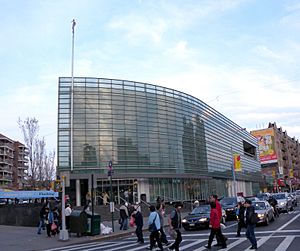
Flushing had the first public library in Queens, started in 1858. Today, the Queens Public Library has five branches in Flushing.
The Flushing branch is the largest. It is at Kissena Boulevard and Main Street. It is the busiest library branch in the United States. This library has an auditorium for public events. The current building is the third on this site. The first was a Carnegie library, funded by Andrew Carnegie.
Other branches include:
- East Flushing – 196-36 Northern Boulevard
- McGoldrick – 155-06 Roosevelt Avenue
- Mitchell-Linden – 31-32 Union Street
- Queensboro Hill – 60-05 Main Street
Getting Around Flushing
Public Transportation
Many MTA Regional Bus Operations bus routes serve Flushing. These buses connect Flushing to other parts of Queens and beyond.
- Q12: to Little Neck
- Q13: to Fort Totten
- Q15 and Q15A: to Beechhurst
- Q16: to Fort Totten
- Q17: to Jamaica
- Q19: to Astoria
- Q20A/B: to Jamaica or College Point
- Q25: to Sutphin Boulevard–Archer Avenue–JFK Airport (E J and Z trains) or College Point
- Q26: to Fresh Meadows
- Q27: to Cambria Heights
- Q28: to Bay Terrace
- Q34: to Sutphin Boulevard–Archer Avenue–JFK Airport (E J and Z trains) or Linden Hill
- Q44 SBS: to Jamaica or West Farms, Bronx
- Q48: to LaGuardia Airport
- Q50: to Co-op City, Bronx
- Q58: to Myrtle–Wyckoff Avenues (L and M train)
- Q65: to Sutphin Boulevard–Archer Avenue–JFK Airport (E J and Z trains)
- Q66: to Queensboro Plaza (7 <7>, N, and W trains)
The Nassau Inter-County Express (NICE) bus route n20G also ends in Flushing.
Flushing has one New York City Subway station: Flushing–Main Street. It is served by the 7 <7> trains train. This is one of the busiest subway stations in the city.
The Long Island Rail Road's Port Washington Branch also serves Flushing. Its stations are:
- Mets–Willets Point
- Flushing–Main Street
- Murray Hill
- Broadway
Roads and Highways
Major highways in the area include the Van Wyck Expressway and Whitestone Expressway. These are part of Interstate 678. The Grand Central Parkway and Long Island Expressway (Interstate 495) also serve Flushing. Northern Boulevard (New York State Route 25A) runs through Flushing. It connects to the Queensboro Bridge and goes into Nassau County. The Roosevelt Avenue Bridge over Flushing Creek was once the largest of its kind.
Famous People from Flushing
- Judd Apatow (born 1967), director and producer
- Action Bronson (born 1983), rapper
- Godfrey Cambridge (1933–1976), comedian and actor
- Joseph Cornell (1903–1972), artist
- Fran Drescher (born 1957), actress from The Nanny
- Jimmy Durante (1893–1980), singer and comedian
- Jon Favreau (born 1966), actor, producer, and director
- F. Scott Fitzgerald (1896–1940), famous novelist
- Marvin Hamlisch (1944–2012), composer
- Lewis Latimer (1848–1928), inventor
- Martin Lawrence (born 1965), actor and comedian
- Robert Moog (1934–2005), inventor of the Moog synthesizer
- Nancy Reagan (1921–2016), former First Lady
- Martin Scorsese (born 1942), Oscar-winning movie director
- David Schwimmer (born 1966), actor from Friends
- Paul Stanley (born 1952), member of the band KISS
- Henry E. Steinway (1797–1871), founder of Steinway & Sons pianos
- Harvey (born 1952) and Bob Weinstein (born 1954), film producers
- John Williams (born 1932), Academy Award-winning film composer
Images for kids
See also
 In Spanish: Flushing para niños
In Spanish: Flushing para niños


